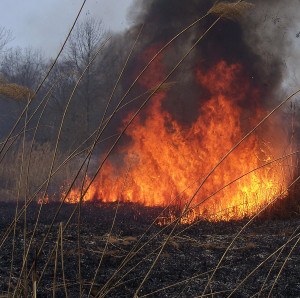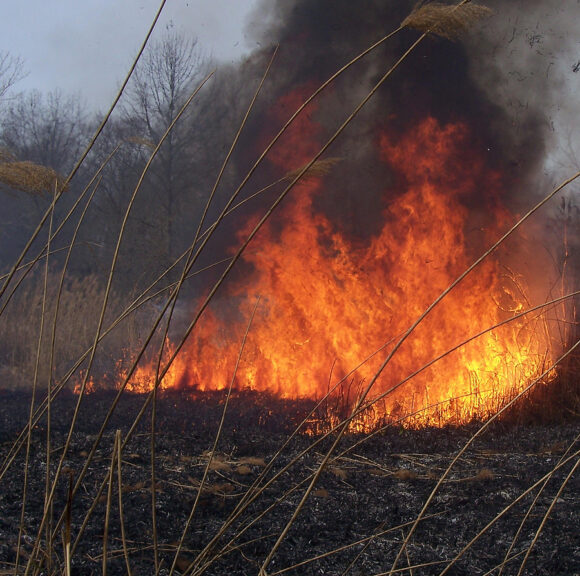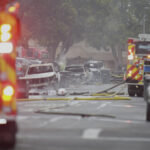The West’s 2012 wildfire season exploded in earnest last month with a wind-whipped blaze that killed three people in rugged alpine canyon country near Denver. It took a 700-strong federal firefighting team a week of labor, day and night, to tame the blaze – and other states throughout the West took notice.
Fire experts say this year’s drought, low snowpack and record-high temperatures in much of the West portend a dangerous installment of what has become a year-round wildfire threat.
Wildfires burned more than 1,500 square miles in Arizona last year and have already torched about 12 square miles this year. Most were caused by people, and fire officials hope the public has learned some lessons from the Wallow Fire, the worst in state history. Campfire embers ignited a blaze that forced nearly 10,000 people to evacuate their homes.
New Mexico, too, experienced its two biggest-ever wildfires in 2011, consuming 245 and 160 square miles, respectively.
“We are approaching this as a season where we still have very high fire danger and there are millions of acres around New Mexico that could burn,” said Dan Ware, a New Mexico State Forestry Division spokesman.
January and February were the driest on record in California, where the state Department of Forestry and Fire Protection has battled 679 fires in its jurisdiction – about a third of the state – since Jan. 1, compared to 210 over the same period last year. Fire threats are expected to be above normal in the mountains, the central coast and inland areas such as San Bernardino County, said department spokesman Daniel Berlant.
Nearly all of Arizona, California, Colorado, New Mexico, Nevada and Utah have drought conditions that should persist at least through June, according to the National Drought Mitigation Center in Lincoln, Neb.
For much of the West, snowfall this winter was disappointing. Snowpack in Colorado and Utah is only half of average and diminishing fast. Salt Lake City reported its fourth-driest March ever; Denver had a trace of precipitation in what traditionally is the snowiest month of the year.
“Things are heating up and drying out,” said Jason Curry of the Division of Forestry, Fire and State Lands in Utah, where fire officials monitor parched high grasses left over from bountiful 2011 precipitation. “We’ve got our eyes on the hills.”
In many areas, grass, brush, timber and other wildfire fuels didn’t get a winter soaking that allows them to retain water. California had a few storms in March, but “when you miss three or four months without any rain, it just becomes too late,” Berlant said.
The National Interagency Fire Center in Boise, Idaho, expects to issue its comprehensive regional outlook May 1. Jeremy Sullens, a wildfire analyst with Predictive Services, an interagency group affiliated with the center, said many states are still transitioning to spring and that green-up – the growth of grasses and plants that provide initial fuel for forest and rangeland fires – is in the early stages.
“One of the major factors for the fire season is how precipitation patterns develop through the spring,” Sullen said. “So even if we’re seeing warmer temperatures in many states across the West, it’s all really variable at this point.”
The West’s typical wildfire season has run from May to October, peaking in summer months. But climate change and the decades-old practice of putting out fires that nature intended to burn – eliminating fuels – has created a season that starts earlier and sometimes run longer, said Tim Brown, director of the Western Regional Climate Center in Reno, Nev. Fire managers first noticed the trend in the 1990s.
Idaho is one state that expects a mild wildfire season – at least for now. Its mountain ranges are at normal snowpack levels, reservoir managers are dumping water to make room for snowmelt, and the first weeks of spring have brought more snow and rain, even to the desert-like climate of southern Idaho.
Elsewhere in the northern Rockies, fire officials expect a normal 2012 after last year’s cool weather and spring floods all but eliminated fire season. Snowpack in Montana and northern Wyoming is at historically average levels, and barring a rapid warm-up, fire season is expected to start in mid-July, said Bryan Henry, a meteorologist with the Northern Rockies Coordination Center’s predictive services.
The exception is the plains of eastern Montana, where snow was less than usual this winter, and brown grass is standing tall as potential fuel before the spring green-up.
“A couple of dry, windy days, it will be ready to burn,” Henry said.
It did already in Colorado. High winds fanned a 37-square-mile grassfire on the eastern plains in March, creating blinding clouds of dust and smoke and injuring three firefighters as they tried to escape a stranded fire truck.
The millions of acres of pine forest, from Canada to Colorado, scarred by the telltale red needles of trees killed by the mountain pine beetle pose another fire uncertainty. Residents of small towns worry about firestorms erupting in beetle kill on surrounding mountainsides. But it isn’t known whether the red forest canopies pose a more serious threat.
Matt Jolly and Russ Parsons, U.S. Forest Service ecologists, suggested last year that dead needles can ignite up to three times faster than the green needles of a healthy tree. Beetle-killed trees can burn more intensely and carry embers farther, Jolly said.
Jolly and Parsons are using the data to create models to better predict how a fire will act in stands of beetle-killed trees, but those models aren’t ready yet, Parsons said.
Jolly said he did observe a fire last year at the Idaho-Montana line that grew by 26 square miles in a single day when the fire danger was moderate at best. The blaze spread quickly in crown fires through stands of beetle-killed trees as though there had been a prolonged drought, he said.
That is a fearsome thought in a region where firefighters and residents are already bracing for what could be another rough year.
In New Mexico, hundreds of wild land firefighters have been already been trained, and state and federal land managers have been meeting with communities and homeowners to talk about preparing for the worst.
Just last week, officials gathered in the mountain community of Ruidoso for a two-day summit dedicated to dealing with fire in communities that border forests, grasslands and hill country. The officials toured burn scars and looked at thinning projects.
Many of the firefighters called in from California and New Mexico to combat the deadly Colorado wildfire had just been hired in what normally passes as pre-fire season, said Rich Harvey, incident commander for the fire and a deputy state forester with the Nevada Division of Forestry. Now, he said, “there is a sense of urgency to get firefighters hired on.”
“You should be skiing at 8,000 feet in Colorado, not fighting fires in March,” Harvey said. “It looks like July on the ground.”
(Associated Press writers Todd Dvorak in Boise, Idaho, Susan Montoya Bryan in Albuquerque, N.M., Robert Jablon in Los Angeles, Felicia Fonseca in Flagstaff, Ariz., Matt Volz in Helena, Mont., Paul Foy in Salt Lake City, Jeff Barnard in Grants Pass, Ore., Ken Ritter in Las Vegas, Jennifer Kelleher in Honolulu and Bob Moen in Cheyenne, Wyo. contributed to this report.)
Was this article valuable?
Here are more articles you may enjoy.


 Hackers Abuse Modified Salesforce App for Data Theft and Extortion, Google Says
Hackers Abuse Modified Salesforce App for Data Theft and Extortion, Google Says  Plane Crashes into San Diego Neighborhood, Setting Homes And Vehicles on Fire
Plane Crashes into San Diego Neighborhood, Setting Homes And Vehicles on Fire  Four Ex-VW Managers Convicted in Germany Over Diesel Scandal
Four Ex-VW Managers Convicted in Germany Over Diesel Scandal 